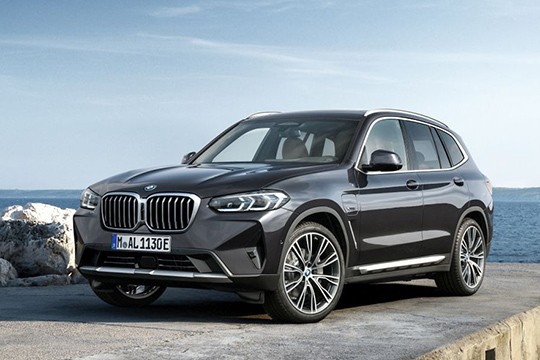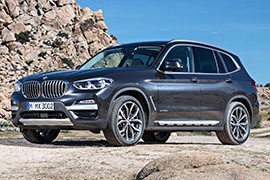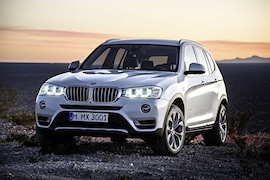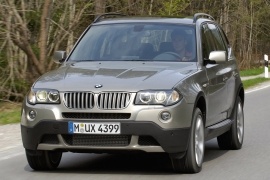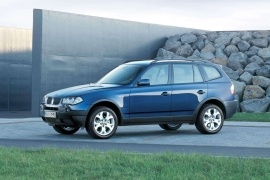BMW X3 Models/Series Timeline, Specifications & Photos
First production year: 2004
Engines: Mild hybrid diesel, Mild hybrid, Hybrid gasoline, Gasoline, Diesel
Body style: SUV (Sports Utility Vehicle)
Four years after introducing the third generation of the X3, BMW introduced a refreshed version for it, with upgrades in all the areas: exterior, interior, and drivetrain.
The 2017 X3 shared the same CLAR (Cluster Architecture) platform with its bigger brother, the 2019 X5. Worth mentioning that the third X3 generation was already more extended than the first X5 generation. The X3 already matched its bigger brother's technologies with the facelifted version and offered a better choice for an all-around vehicle. Since it was shorter than the fourth-generation X5, it was easier to drive it in cities.
From the outside, the X3 LCI (life-cycle impulse) featured a new front bumper with an enlarged kidney grille with a single section frame. Its standard LED headlights, with an option for Matrix LED, were 10 mm (0.4") flatter. On the sides, all versions came fitted as standard with specific side-sills, finished in light gray. At the back, there was a new design for the taillights with horizontal turn signals. Depending on the version, the car featured new flush-fitting free-form exhausts.
Inside, BMW installed a 10.25" wide format infotainment screen above the center stack, with an option for a 12.3" display, in the same free-floating look. All versions featured a three-zone automatic climate control for more comfort on the rear seats. The redesigned center console featured a new shape for the gear-selector and the iDrive's rotary knob.
Under the hood, the most significant upgrade was the electrification, which brought a new 48-volt system. All engines showed better fuel efficiency. Apart from vehicles fitted with internal combustion engines only, the carmaker also offered an option for a plug-in hybrid.
BMW X3 M40d 48V 8AT AWD (340 HP)
The BMW X3 reached its third generation already. It was the vehicle that started the SAV (Sport Activity Vehicle) lineup in BMW back in 2003. In 2017 evolved in both terms of design and technology. The platform, design, engines, and interior are new. The only part that was kept was the 8-speed automatic gearbox from ZF. But even that had received some software updates.
On the outside, a bigger grille appeared on the front and, in the bumper, there are other three openings for cooling the engines and brakes. In the center, hidden behind the mesh, is the radar for adaptive cruise control and AEBS that helps the driver to avoid crashes. The 2017 X3 is slightly bigger than the previous generation by 56 mm (2.2”), which was added to the wheelbase that now has 2864 mm (112.8”). That is good for the rear seat passengers.
For the driver, BMW installed a new semi-automated driving system that allows the vehicle to keep its lane, follow the car in front at a safe distance and brake if necessary and even take turns. Since the autonomous driving was not regulated, the driver still has to keep a hand on the wheel. At least from time to time when the car asks for.
The base engine is a new, 2.0-liter gasoline unit that offers 181 hp, while the top version is the X3 M Competition that punches 503 hp! Two turbodiesel engines are offered and also a 293 hp plug-in hybrid version.
The second generation of the BMW X3 has received a facelift in 2014. As usual for the German brand, the refreshed version brought more grunt under the hood and a revised look.
Back in 2003, BMW launched the first generation of the X3. The brand's officials didn't name the car as an SUV, but as SAV – Sports Activity Vehicle. The idea behind the name was that the car was sportier than other SUVs from its segment. It was an SUV built for the road, but with decent off-road abilities.
The redesigned, 2014 X3 was longer by 1 cm (0.4”) by the new design for the bumpers. The front fascia featured new headlights, which were offered as an option with LED. The foglights were also available with the LED technology as an option. The rearview mirrors were redesigned and incorporated the LED turn-signals.
Inside the vehicle, new materials and new colors were available. The big trunk could take 550 liters (19.4 cu-ft) that could have been extended up to 1600 liters (56.5 cu-ft). The tailgate featured an optional hands-free open/close system by swiping the foot under the bumper.
The X3 was available as rear-wheel-drive or all-wheel-drive. The former was used only for specific engines, while the latter was the most common option and it was standard for most of the engines/transmission configurations. A newly developed 2.0-liter turbodiesel with twin-turbo was available and it offered 190 hp. The standard transmission for most of the models was a 6-speed manual, while an 8-speed automatic was offered as an option or standard for specific engines.
The first compact crossover from a luxury sedan brand, the BMW X3 was revealed for the first time in 2003.
The second generation BMW X3 was released in 2010 at the Paris Auto Show. Larger than its predecessor, the new X3 was similar to the X4 in terms of exterior design.
The main target of the new model was to increase comfort and space. While the first generation had a somewhat cramped interior and offered a rough ride, the then-new X3 improved these aspects.
While the suspension was redesigned to improve the ride quality, the X3 still remained solid, with a very responsive handling.
Even with a taller center of gravity, the X3 still handled like a 3-Series on the track.
Inside, the fit and finish was highly improved, giving an athletic feel.
Two trim levels were available with the second generation: the xDrive 28i and the xDrive 35i.
Standard features included 17-inch alloys, automatic headlights, fog lights, rain-sensing windshield wipers, leatherette upholstery, automatic climate control, cruise control, Bluetooth connectivity, the new BMW iDrive interface and a 12-speaker sound system.
With the xDrive 35i, the X3 came equipped with 18-inch alloys and adaptive xenon headlights.
Many options bundled into packages were offered, such as the Sporty Activity package that added sport front seats, roof rails and a sport transmission with paddle shifters, the Premium package with a sunroof and leather upholstery, the Dynamic Handling that added adaptive suspension dampers, and three driver selectable drive modes, as well as a Cold Weather package with heated front seats and a heated steering wheel.
Other stand-alone options were also offered, such as bigger 19-inch alloys, a rear-view camera, a head-up display, a power liftgate and a premium sound system.
BMW introduced the BMW X3 in 2003 and, in October 2006, it launched the mid-life cycle refresh that changed more parts in and out of the vehicle.
BMW launched the 5-Series based X5 in 1999 and, four years later, the X3. It named its vehicles as Sports Activity Vehicle, or SAV for short, since it considered that those cars will be used mostly on paved roads and only rarely on soft off-road situations. They were absolutely right about that, but most of the X3s and X5s were built with all-wheel-drive.
The 2006 X3 LCI (Life Cycle Impuls) received new headlights that, along with the foglights, formed a “six-eye” look for the car. The front bumper was redesigned with distinctive separation for the upper and lower part. The same principle was applied in the back with the rear bumper. New taillights design was also introduced.
Inside, there was a new, three-spoke, steering-wheel and galvanized metal for the door handles. The improvements in the interior material quality were made also for the upholstery.
Usually, when BMW does an LCI, the biggest improvements are under the hood. For the 2006 X3, the car-maker dropped some engines and improved or completely changed others. For the suspension, the standard model already featured a stiff setting for the dampers, but for those who want to trade comfort for handling, a sport-package was available.
After the successful introduction of the BMW X5 on the market, the German carmaker didn't wait for too much to launch a smaller version and the first generation of the BMW X3 appeared in 2003.
In the fall of 2003, at the Frankfurt Auto Show, BMW unveiled the smaller brother of the X5. It was a car that didn't have too many competitors on the market, except for the Land Rover Freelander, which was developed under the BMW management. With a platform taken from the BMW 3-Series, the X3 had the same rear suspension with the compact sedan.
The design was arguably one of its strongest elements and the car was blamed to look like a station-wagon on stilts. The unusual headlights design was changed on the mid-life cycle refresh in 2007.
Inside, there was room for five adults, with enough headroom and decent legroom for the rear passengers. In the dashboard, there was an option for the iDrive infotainment system, controlled via a rotary knob on the center console. There were more options for the infotainment unit, including a BMW AM/FM/M-CD Radio with eight speakers. A large panoramic sunroof was on the options list.
The traction system was jointly developed with Magna Steyr from Austria, where the SUV was built. All X3 models feature BMW's all-wheel-drive system, with a default 40:60 torque split between the front and rear axles and the ability to direct all torque to either axle. The system used an electronically controlled multiple-plate clutch to enable infinitely adjustable, fully variable distribution of torque from front to rear with the capability of up to 100 percent of engine torque going to either axle. The engine options were of 2.0- and 3.0-liters, with four and six cylinders, respectively.
